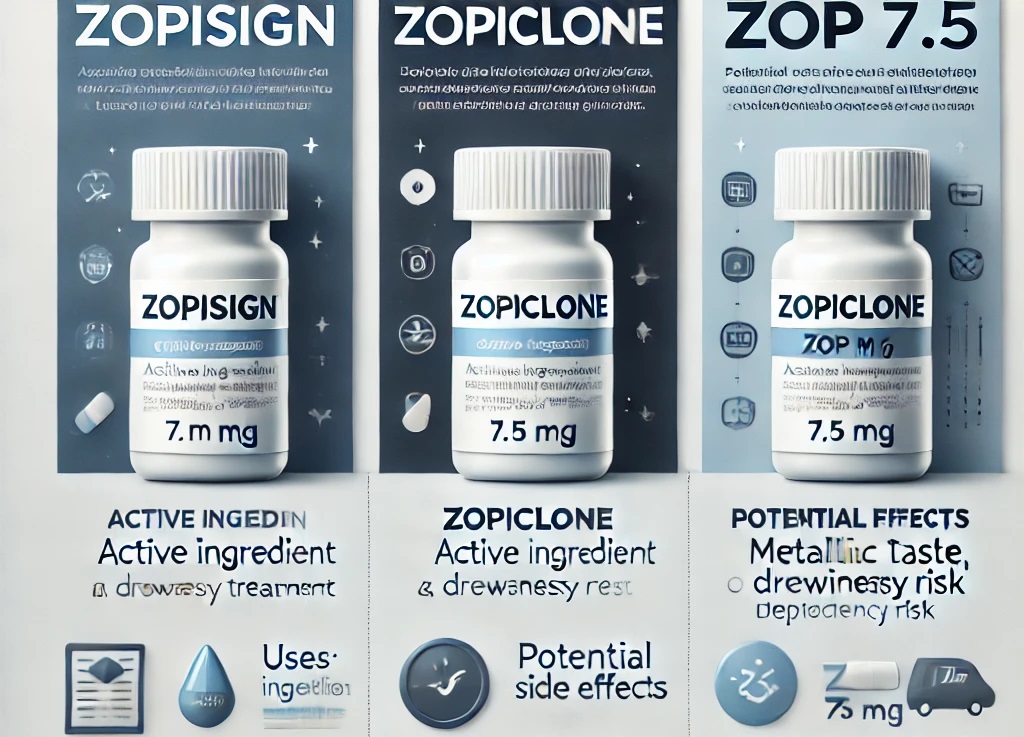Your cart is currently empty!

Sleep disorders, such as insomnia, are increasingly common in today’s fast-paced world, and medications like Zopisign vs. Zopiclone vs. ZOP 7.5 are frequently prescribed to manage such conditions. While these medications may seem similar at first glance, there are subtle differences in branding, formulations, and patient experiences that distinguish them. Below, we delve into a detailed comparison to help understand how they stack up against each other.
1. What Are Zopisign, Zopiclone, and ZOP 7.5?
Zopiclone
Zopiclone is a well-known prescription medication in the class of non-benzodiazepine hypnotics. It is used to treat short-term insomnia by promoting sleep onset and reducing nighttime awakenings. Available in doses like 3.75 mg and 7.5 mg, Zopiclone works by modulating gamma-aminobutyric acid (GABA) receptors in the brain, which helps induce relaxation and sleep.
Zopisign
Zopisign is a generic version of Zopiclone. Manufactured by various pharmaceutical companies, it contains the same active ingredient but may vary in non-active components such as fillers or binders. Like Zopiclone, Zopisign is available in 7.5 mg tablets and is commonly used to address acute or chronic insomnia. Its affordability compared to branded Zopiclone makes it a popular choice for budget-conscious patients.
ZOP 7.5
ZOP 7.5 is another generic formulation of Zopiclone. It is essentially identical to Zopisign in terms of active ingredients but may be marketed under a different name depending on the manufacturer. The “7.5” in its name refers to the standard therapeutic dose, which is effective for most adults suffering from sleep disorders.
2. Similarities Among the Medications
- Active Ingredient: All three medications contain Zopiclone as the active component, meaning their therapeutic effects on sleep induction and maintenance are fundamentally the same.
- Mechanism of Action: They act on the central nervous system by enhancing GABA activity, a neurotransmitter that calms the brain, facilitating sleep.
- Dosage: The most common dose for all three is 7.5 mg, though lower doses like 3.75 mg may be used for elderly patients or those sensitive to medication.
- Uses: All are primarily prescribed for short-term management of insomnia, especially for difficulties in falling asleep or staying asleep.
3. Zopisign vs. Zopiclone vs. ZOP 7.5 – Key Differences
Branding and Cost
- Zopiclone: As the branded version, Zopiclone is typically more expensive due to its established reputation and higher production costs.
- Zopisign: As a generic drug, Zopisign offers a more affordable alternative, making it accessible to a broader population without compromising efficacy.
- ZOP 7.5: Another generic variant, it is priced similarly to Zopisign but may differ in availability depending on the region.
Inactive Ingredients
The fillers and binders used in generic formulations like Zopisign and ZOP 7.5 may differ slightly from branded Zopiclone. These variations rarely affect efficacy but might influence tolerance in patients with sensitivities or allergies.
Manufacturing Standards
While Zopiclone is typically produced by reputed global pharmaceutical companies, generic versions like Zopisign and ZOP 7.5 might come from various manufacturers, which can result in minor variations in quality control practices.
4. Patient Experiences and Effectiveness
Efficacy
Most patients report that all three medications effectively promote restful sleep, with minimal differences in overall effectiveness. Some anecdotal reports suggest that branded Zopiclone may have a slightly faster onset, but this perception is subjective and not supported by clinical studies.
Side Effects
Common side effects, such as a metallic taste in the mouth, drowsiness, and occasional grogginess, are reported across all three. Patients may experience these effects differently based on individual tolerances and formulations.
Dependency Risk
All three medications share a similar potential for dependency if used long-term, which is why they are typically prescribed for short durations. Cognitive Behavioral Therapy for Insomnia (CBT-I) is often recommended as a complementary or alternative treatment.
5. Choosing the Right Medication
The choice between Zopisign, Zopiclone, and ZOP 7.5 often comes down to factors such as:
- Cost: Patients seeking cost-effective solutions often prefer generics like Zopisign or ZOP 7.5.
- Brand Loyalty: Some individuals may prefer the reassurance of using a branded medication like Zopiclone, especially if their insurance covers the cost.
- Availability: In some regions, certain brands or generics may be more readily available, influencing the prescribing decision.
6. Precautions and Recommendations
- Short-Term Use: Regardless of the brand, these medications should not be used beyond the prescribed duration to minimize dependency risks.
- Consultation: Always consult a healthcare provider before switching between brands or generics, as even minor differences can affect individual responses.
- Lifestyle Changes: Combining medication with good sleep hygiene practices can enhance long-term sleep quality.
Conclusion
Zopisign vs. Zopiclone vs. ZOP 7.5 are effective treatments for insomnia, sharing the same active ingredient and mechanism of action. The choice between them often depends on individual needs, cost considerations, and regional availability. While branded Zopiclone offers the reliability of a well-known name, generics like Zopisign and ZOP 7.5 provide affordable alternatives without sacrificing effectiveness. Consulting with a healthcare professional is crucial to determine the best option tailored to your specific requirements.
Comments
One response to “Zopisign vs. Zopiclone vs. ZOP 7.5”
Hi, this is a comment.
To get started with moderating, editing, and deleting comments, please visit the Comments screen in the dashboard.
Commenter avatars come from Gravatar.